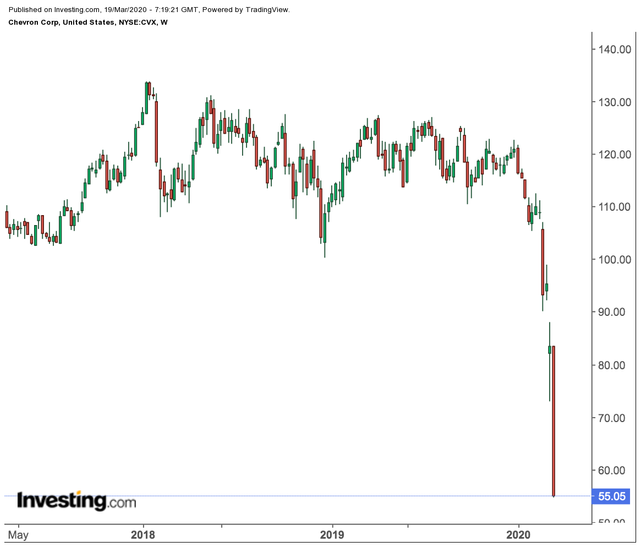Following the recent, rapid collapse in oil prices, the world has suddenly changed dramatically for the largest oil companies in the U.S. and their investors. Triggered by what looks like the perfect geopolitical storm, the coronavirus pandemic and the price war between Saudi Arabia and Russia, the next danger lurking ahead for big oil is a cut to their previously rock-solid dividends.
And, looking at their dividend yields, it seems the market is already pricing in that possibility. Shares of Exxon Mobil (NYSE:XOM), which have plummeted 45% in the last month, and Chevron (NYSE:CVX), down 50%, are now yielding more than 9%. Exxon shares closed yesterday's session down 10% at $33.12, while Chevron dropped 22% to close at $55.05.
Exxon Mobil Weekly Price Chart  Exxon Mobil Weekly Price Chart
Exxon Mobil Weekly Price Chart
Royal Dutch Shell (NYSE:RDSa), the Anglo-Dutch giant that hasn’t cut payments to shareholders since the Second World War, has seen its 12-month dividend surge to 13% of its current share price. Its shares have fallen 57% in the past four weeks. BP (NYSE:BP) offers a yield of 13.3% after its stock lost 55% since mid-February.
And, as yet, there's no indication that this will stabilize any time soon. Crude oil prices have accelerated their descent with no sign that the bottom is near. U.S. crude prices plunged to their lowest levels in 18 years yesterday, as governments worldwide introduced new travel restrictions and the Saudi-Russian price war intensified.
West Texas Intermediate futures—the main U.S. crude gauge—dropped 24% to $20.37 a barrel, hitting their lowest level since February 2002. Brent crude, the global benchmark, fell 13% to $24.88 a barrel, its lowest level since May 2003.
EXTREME LEVEL OF DISTRESS
While the yield on oil stocks is already showing an extreme level of financial distress, it’s hard to predict which producers will ultimately take the dangerous route of cutting their sacred payouts — many of which have endured numerous downturns and even survived the financial crisis of 2008.
Exxon Mobil CEO Darren Woods said at the company's investor day on March 5 that Exxon is “committed to a reliable and growing dividend.” The company has increased the payout each year for the past 37 years.
Chevron’s CEO Mike Wirth also reiterated recently that the integrated energy producer is on track to raise its annual, per-share payout for the 33rd time in 2020.
Chevron Weekly Price Chart  Chevron Weekly Price Chart
Chevron Weekly Price Chart
Assuming that some of these payouts are safe for the time being, the first major action these oil majors can take to deal with this massive price shock is to rerun to the 2014 playbook, when they drastically reduced their spending and discontinued share buyback plans.
Exxon said on Monday it’s partially reversing course on an ambitious spending program and weighing significant cuts after its credit rating was downgraded by S&P Global Ratings. Chevron said last week that it’s considering options for cutting capital spending and curbing short-term production. BP Chief Financial Officer Brian Gilvary said the British energy major could shrink spending by as much as 20% this year.
But according to some analysts, if the price of oil stays around $35 a barrel, even dividends may not be spared. Market expectations for Big Oil dividends have been reduced over the past two weeks, pricing in a 37% cut from 2019 dividends for European majors in 2021.
“In past oil downturns, Big Oil on aggregate did not respond to challenging macro conditions through material dividend cuts,” Goldman Sachs analysts said in a note, adding that they do not expect a cut because of the current environment.
Bottom Line
There is no doubt that oil majors are in a very tough spot after the sudden plunge in oil prices. They don’t have many options at their disposal with which to deal with this demand shock other than cutting spending and preserving cash.
At that same time, it’s highly risky to bet on their swelling dividend yields and potential future payouts. Nothing looks sacred as long as the Saudi-Russian price war continues.
Warning! This user is on our black list, likely as a known plagiarist, spammer or ID thief. Please be cautious with this post!
If you believe this is an error, please chat with us in the #appeals channel in our discord.
Downvoting a post can decrease pending rewards and make it less visible. Common reasons:
Submit
Join the community in our migration to Hive, a community built blockchain for the community. All Steem account holders will receive equivalent stake on the new Hive blockchain.
Please see this post on SteemPeak for more information.
Downvoting a post can decrease pending rewards and make it less visible. Common reasons:
Submit